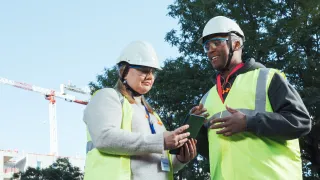Work in the heat - risk management at workplaces - HeatFit

Objectives
The current recommendations for working in hot conditions are based on the temperature of the working environment, not the responses caused by heat in the employee. Now we are producing practical recommendations for workplaces on work-rest cycles and recovery from hot work.
The recommendations are intended for workplaces where hot work is carried out and for periods of high temperatures (25°C and over) in general. The recommendations are now being drawn up for the first time for a population living in subarctic conditions in the north. In the past, studies have only been carried out in warm countries where people have as a rule become adapted to higher temperature.
Data and methods
The research is divided into laboratory and data research.
In the laboratory study, we will use extensive physiological and cognitive measurements to examine how the temperature and intensity of work affect loading of the cardiovascular and neuromuscular systems as well as the thermal load of the body.
We are also examining body core temperature:
- How does core temperature behave at different working temperatures and at different working intensities?
- How long before body core temperature is restored at room temperature if no cooling methods are used?
In the data research, we will utilise the results of the Finnish Institute of Occupational Health’s Climate Change and Work survey (2022). The data is a representative sample of employees in Finland. On the basis of the survey results, we can therefore form generalisations on the instructions provided on hot work at workplaces and how familiar employees are with hot work practices.
Using the current situational picture obtained from the data, we will create recommendations for preparing for hot work at workplaces. Other projects carried out by the research group at the Finnish Institute of Occupational Health over the previous 15 years will also be used in drawing up the recommendations.
Results and impact
Based on the results, we will create rest and recovery cycle recommendations for moderate and heavy work performed in hot conditions. The recommendations can be used at workplaces to reduce occupational health and safety risks and to maintain the employees' functional capacity and the productivity of work.
The recommendations take into consideration that Finland is part of the subarctic climate zone. This means that people living here have become more adapted to cold temperatures than to hot temperatures. Thus, the recommendations made in hot countries are not directly applicable to people living in subarctic climates.
The recommendations and action recommendations produced by the project will make it possible for workplaces:
- to gain more understanding of the risks of increasing hot work and how to adapt to these.
- to prepare for the increase in workload caused by periods of high temperatures (25°C and over) and prevent the deterioration of work ability and accidents.
- to provide support for the proactive preparedness of supervisors' for working in hot conditions in different workplaces.
In addition, the recommendations support the manner in which occupational safety legislation and occupational safety and health activities respond to the new occupational safety and health risks caused by hot work.
The recommendations produced by the project will harmonise general instructions for hot work aimed at workplaces. Based on the results
- We will be better able to identify an increase in hot work resulting from climate change. Its amount may differ from what is stated in previous reports.
- We receive information on current workplace practices in adapting to hot work and its shortcomings.
- We can focus information especially on sectors where improvements are needed to hot work adaptation measures.
Our experts

Jutta Karkulehto
Research group
Fanni Moilanen, Researcher
Satu Mänttäri, Chief Researcher
Juha Oksa, Chief Researcher
Teemu Paajanen, Senior Psychologist
Ari-Pekka Rauttola, Senior Specialist
Pihla Säynäjäkangas, Researcher
Partners
- Finnish Food Workers' Union
- Talonrakennusteollisuus ry
- Finnish Asphalt Pavement Association (FAPA)
Funding
The Finnish Work Environment Fund



